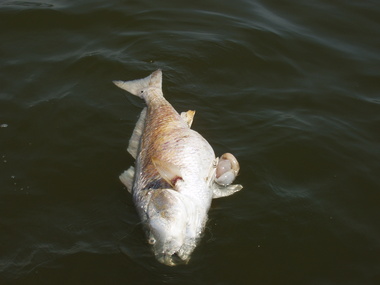Alabama Marine Resources Department personnel, who surveyed the situation on the water Thursday, estimate finding nearly 400 floating in the bay with about 100 dead hardhead catfish mixed in.
Red drum are commonly called redfish, with the larger specimens known as bull redfish because of their hard-charging fighting ability when hooked by fishermen.
A die-off involving the same size and number of redfish and catfish happened during the last couple of days in April 2012.

"It's disturbing," said Chris Blankenship, Director of Alabama's Marine Resources Division. "It does seem very unusual that it's happened in the same place at nearly the same time of year. I don't ever recall it being an annual thing."
Brooks Delaney reported seeing more than 20 dead redfish as he ran from Fish River to Little Point Clear and back during a Friday morning fishing trip. All of the fish appeared to be larger than Alabama's 16- to 26-inch slot limit.
He added that some of the fish appeared to have died recently, but most were well along in the decomposition process.
As was the case last year, Blankenship said all of the fish MRD personnel encountered were far too decomposed to provide valid samples for scientific testing.
"All of the fish seemed to have been dead two or three days at the least. We can't send them off for causational bacterial testing because bacterial growth upon their death has already begun," he said.
As was the case last year, absent any kind of scientific proof, he said it will be almost impossible to determine what has caused this die-off.
Results of salinity tests MRD personnel conducted Thursday showed a heavy influx of freshwater in Mobile Bay had sent levels down to 7 parts per thousand, Blankenship said.
A normal salinity level for early May would be more than double that level, but he did not think it was so low as to kill a large fish species such as redfish.
"With all the rain we've had recently, there's a lot of freshwater coming down, but redfish should be able to handle that," he said.
Dr. Sean Powers, a Dauphin Island Sea Lab fisheries scientist who has been studying redfish for 16 years, said, like last year's kill, he's not concerned about its impacts on the Gulf's redfish population.
"Obviously, it concerns me that this is a repeated event," Powers said. "It's very strange."
Many fish kills are the result of low dissolved oxygen in the water, but Powers said large redfish are usually able to avoid it.
Plus, low dissolved oxygen is most often an issue during the oppressive heat of summer and water even in dynamic environments such as Mobile Bay can stagnate in pockets, especially at night when oxygen-producing microscopic plants in the water quit producing it.
Based on remote readings at Middle Bay Lighthouse and Cedar Point, daytime and nighttime dissolved oxygen levels have remained well above the 2 milligrams per liter level that Powers said is critical for fish to thrive.
Age-composition results from ear-bone samples taken from fish by Sea Lab personnel during the 2012 die-off showed that the fish ranged from 7 to 25 years old.
Powers added that these die-offs are not the result of natural mortality.
"With natural mortality, you would have a little bit of the population die every year. It wouldn't all happen at the same time," he said.
Blankenship said there are no plans to try to catch live fish from the area because similar efforts last year were not effective at pinpointing a potential bacterial cause.
"It just wasn't very effective because the die-off was apparently an isolated, one day event," he said. "We're going to continue monitoring the situation, and in the case of another event, we might consider trying to catch live fish for testing."
Until Thursday, there had been no additional large-scale redfish die-offs reported.



Reader Comments
to our Newsletter